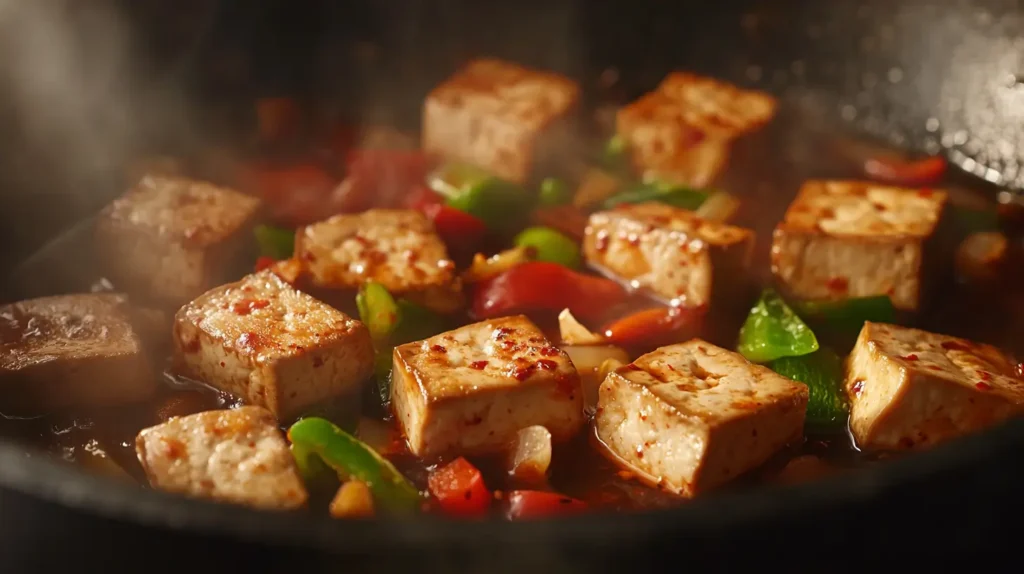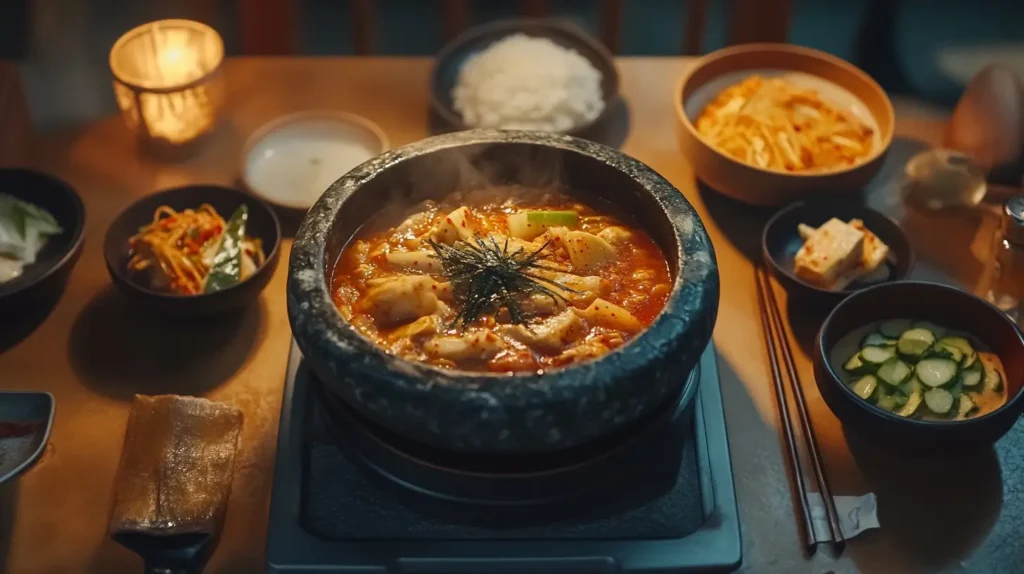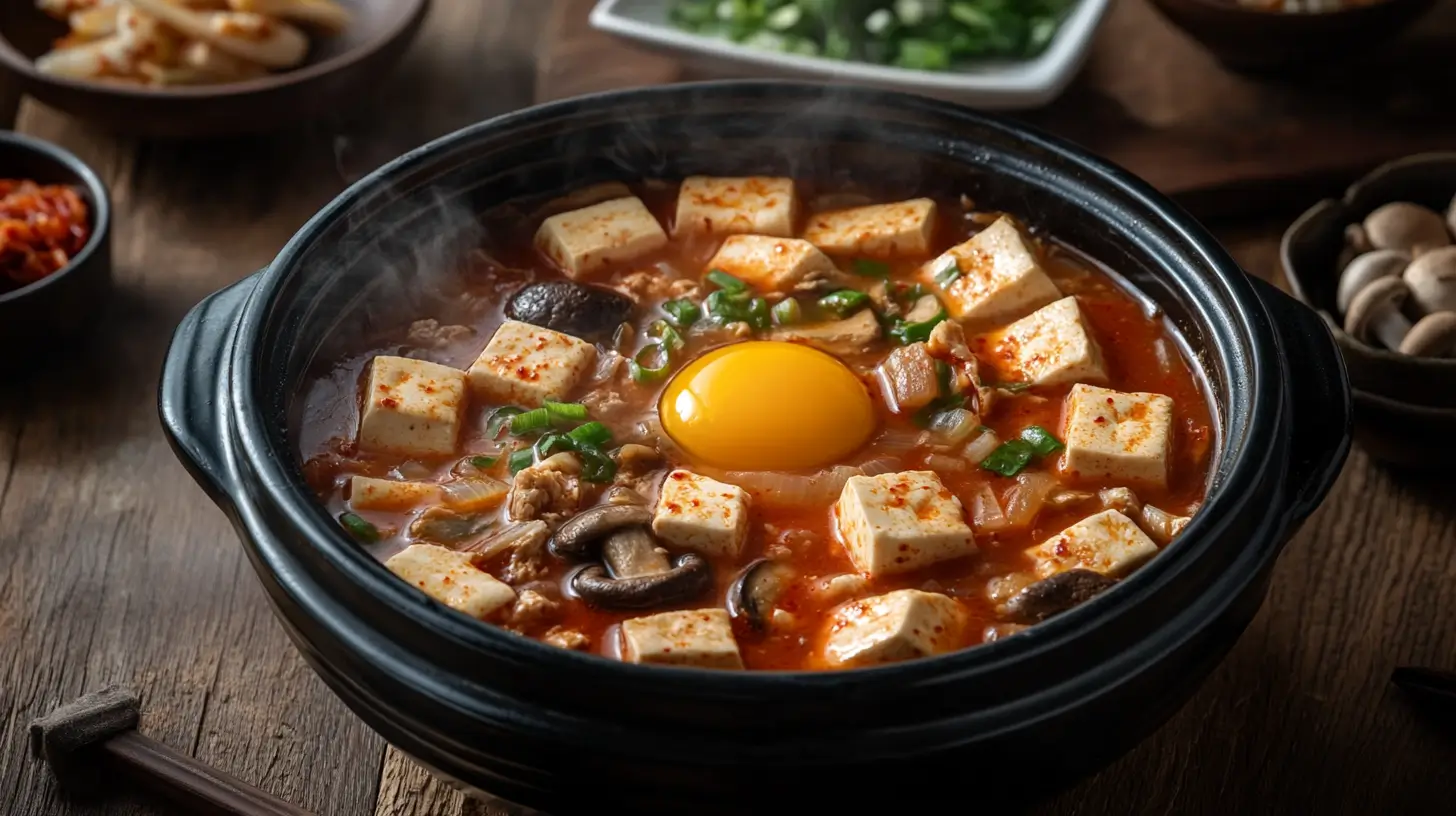1: Introduction to Korean Tofu Soup
What is Korean Tofu Soup (Sundubu-jjigae)?
Korean Tofu Soup, also known as Sundubu-jjigae, is a warm, spicy, and deeply comforting stew made with uncurdled soft tofu, vegetables, and often a protein like beef or seafood. It’s one of Korea’s most beloved dishes and a staple in many Korean households.
Why It’s Loved Worldwide
What makes this soup stand out is its rich umami flavor, the silky texture of tofu, and the bold spiciness from Korean chili flakes. Whether you’re feeling under the weather or craving something hearty, Sundubu-jjigae hits the spot. Its versatility and soul-warming depth have helped it earn fans all over the globe.
Table of Contents
2: Core Ingredients of Korean Tofu Soup
Essential Ingredients for Authentic Flavor

The heart of Korean tofu soup lies in its vibrant ingredients. The foundation starts with soft tofu, often labeled as silken or unpressed tofu, which melts into the broth. Anchovy broth or kelp-based dashi provides that deep, savory base. Kimchi adds tang and fermentation, while garlic and gochugaru (Korean red chili flakes) bring the heat. A raw egg cracked into the bubbling soup at the end gives it a creamy finish.
Popular Additions and Protein Options
While the tofu and broth are essential, the soup becomes even more satisfying with proteins. Common options include thinly sliced beef, fresh shrimp, clams, or a mix of seafood. Mushrooms like enoki or shiitake also enhance the earthy, umami depth of the dish.
3: How to Make Korean Tofu Soup at Home
Step-by-Step Cooking Process
Making Korean tofu soup at home is easier than it looks. Start by marinating thick slices of soft tofu in a simple mix of soy sauce and honey for a couple of hours to deepen the flavor. Heat sesame oil in a pot and sauté chopped garlic, green onions, and mushrooms until aromatic. Add your choice of protein—beef, shrimp, or clams—then pour in anchovy or vegetable broth. Let it simmer gently before adding the marinated tofu and a generous spoonful of kimchi.

Customizing the Spiciness Level
Spice lovers can boost the heat with more gochugaru or even a spoonful of gochujang (Korean chili paste). For a milder version, reduce or omit the chili flakes and rely on the flavor of kimchi juice for a subtle kick. This flexibility makes the soup perfect for both spice novices and heat seekers alike.
4: Variations of Korean Tofu Soup
Seafood vs. Meat-Based Tofu Soup
One of the best things about Korean tofu soup is its versatility. For seafood lovers, clams, mussels, and shrimp add briny depth that pairs beautifully with the spicy broth. Prefer meat? Thin slices of beef or pork belly offer rich, savory flavor and heartiness.
Vegetarian or Vegan Alternatives
Plant-based versions are just as satisfying. Swap the anchovy broth for kelp or mushroom stock, and load the pot with vegetables like zucchini, bok choy, or shiitake mushrooms. Add tofu and a bit of miso paste for umami richness. It’s a comforting, wholesome option that doesn’t sacrifice taste.
5: Serving Suggestions and Side Dishes
Best Korean Side Dishes to Pair
Korean tofu soup is traditionally served with a bowl of steamed white rice and an array of side dishes, known as banchan. Kimchi is a must-have for its spicy tang, while japchae (stir-fried glass noodles) and Korean cucumber salad add refreshing balance.
How to Serve It Traditionally
Sundubu-jjigae is often served in a sizzling hot stone bowl, with a raw egg cracked into the soup right before eating. The heat cooks the egg gently for added richness.

6: Storage and Reheating Tips
How to Store Leftovers Safely
Leftover Korean tofu soup keeps well. Store the broth and solids in an airtight container in the fridge for up to 3–4 days. For longer storage, freeze just the broth (without the tofu) for up to 3 months to maintain texture and taste.
How to Reheat Without Losing Flavor
To reheat, warm the broth on the stovetop until simmering. Reheat tofu separately in a skillet or gently steam it, then combine before serving for the best texture and flavor.
7: Health Benefits of Korean Tofu Soup
Nutritional Profile of Tofu and Broth
Soft tofu is low in calories and packed with plant-based protein, calcium, and iron, making it a great option for vegetarians and health-conscious eaters. The broth—especially when made from anchovy or vegetable stock—is light yet rich in minerals.
Why It’s a Comforting Yet Healthy Dish
Despite its bold flavors, Korean tofu soup is naturally low in fat and high in nutrients. It’s hydrating, warming, and filled with immune-boosting ingredients like garlic, kimchi, and mushrooms. Plus, it’s easy to adapt to specific dietary needs without compromising on taste.
8: Common Mistakes to Avoid
Overcooking Tofu or Proteins
Soft tofu is delicate—overcooking can cause it to break apart or lose its silky texture. The same goes for proteins like shrimp or beef; they should be added toward the end to avoid becoming rubbery.
Not Balancing Spices or Skipping Anchovy Stock
Too much chili can overpower the soup, while omitting anchovy or kelp broth can leave it tasting flat. Balance and umami are key.
9: Frequently Asked Questions (FAQs)
What is Korean tofu soup made of?
It’s typically made with soft tofu, anchovy or vegetable broth, kimchi, garlic, gochugaru (Korean chili flakes), and optional proteins like beef or seafood.
Is Korean tofu soup good for you?
Yes! It’s low in fat, high in protein, and full of fermented and nutrient-rich ingredients like kimchi and tofu.
What does Sundubu-jjigae taste like?
It’s spicy, savory, and deeply flavorful, with a silky texture from the tofu and a warming broth.
Can I make Korean tofu soup without kimchi?
Absolutely. While kimchi adds depth, you can substitute with gochujang or miso for a different but still delicious flavor.
10: Conclusion
Korean tofu soup, or Sundubu-jjigae, is a shining example of how simple ingredients can create something truly extraordinary. With its rich broth, silky tofu, and layers of bold, spicy, and savory flavors, it’s no wonder this dish has earned a place in kitchens around the world. Whether you’re cooking it to warm up on a cold day, soothe your soul, or simply explore Korean cuisine, this soup delivers comfort in every spoonful. Give it a try—you may just find your new favorite go-to recipe.
Author’s Top Recipes Picks:
Cheesy Potato Soup Like Grandma’s
Italian Sausage Soup That Warms the Soul
Print
Korean Tofu Soup Made Simple – Bold Flavor in 15 Minutes
- Total Time: 30 minutes
- Yield: 2 servings 1x
- Diet: Gluten Free
Description
This Korean Tofu Soup is spicy, comforting, and packed with soft tofu, kimchi, and your choice of protein. A warm, umami-rich dish that’s easy to make in just 30 minutes—perfect for a quick dinner that feels like a cozy hug in a bowl.
Ingredients
- 1 pack soft tofu (silken or uncurdled), cut into large chunks
- 1 tbsp sesame oil
- 2 garlic cloves, minced
- ½ onion, sliced
- 1 green onion, chopped (plus extra for garnish)
- ½ cup kimchi, chopped
- 1 tbsp gochugaru (Korean red chili flakes)
- 1 tsp soy sauce
- 1 tsp fish sauce (optional for added umami)
- 1 egg
- 3 cups anchovy broth (or vegetable broth)
- ½ cup mushrooms (shiitake or enoki)
- ½ cup protein (shrimp, beef slices, clams, or tofu for vegetarian)
Instructions
Prepare the Broth:
Heat sesame oil in a Korean stone pot or regular saucepan over medium heat. Sauté garlic, onion, and green onion until fragrant (about 1–2 minutes).Add Kimchi and Seasoning:
Stir in the chopped kimchi and cook for another 2 minutes. Add gochugaru, soy sauce, and fish sauce. Mix well.Add Protein and Broth:
Add your chosen protein and mushrooms. Pour in the anchovy broth and bring it to a boil.Add Tofu:
Gently add the soft tofu, breaking it up slightly with a spoon. Lower the heat and simmer for 10–15 minutes.Crack an Egg:
Just before serving, crack an egg into the center of the bubbling soup. Let it cook for 1–2 minutes or until desired doneness.
Serve Hot:
Garnish with chopped green onions and serve with a bowl of steamed rice and Korean side dishes (banchan).
Notes
- For vegetarian version, use vegetable broth and skip fish sauce.
- Adjust gochugaru to your spice preference.
- Add gochujang for a deeper chili paste flavor.
- You can prep the broth in advance for quick weekday meals.
- Prep Time: 10 minutes
- Cook Time: 20 minutes
- Category: Soup
- Method: Stovetop
- Cuisine: Korean

